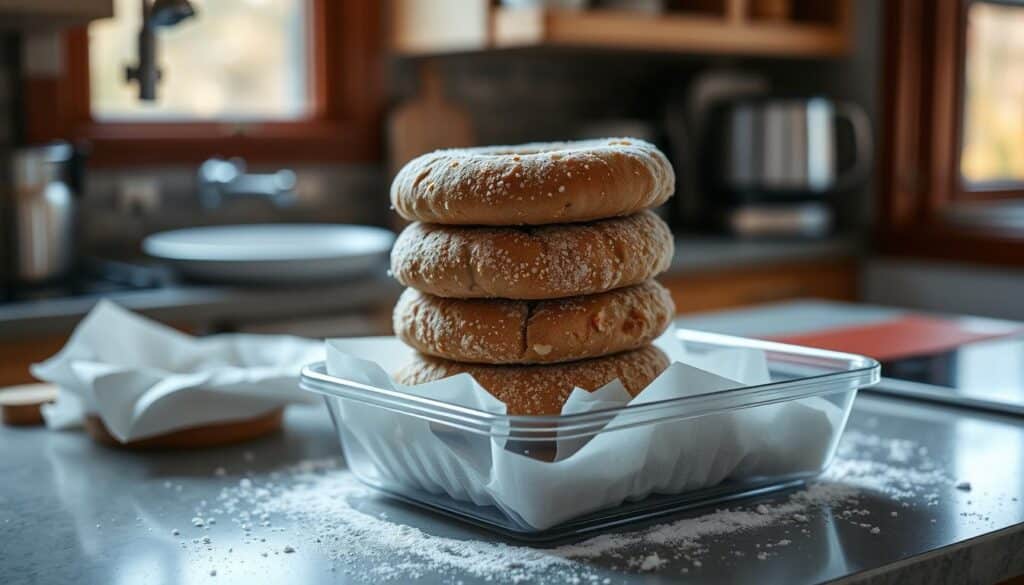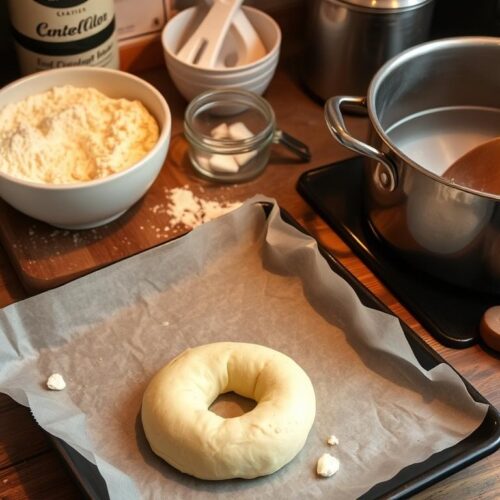Starting your own baking journey to make the perfect snack is truly rewarding. Picture the smell of fresh bread filling your home. You can make this happen with a simple sourdough bagel recipe. Inspired by “Artisan Sourdough Made Simple,” this favorite sourdough bagel recipe makes baking easy without losing the delicious taste. Just prepare the dough the night before, spend 10 minutes getting it ready, and use a top-notch bread flour like King Arthur Flour. Soon, you’ll enjoy yummy NY-style sourdough bagels. They’re shiny on the outside and soft and tasty inside.
Taking two days to bake might seem long, but the outcome is worth it. You’ll get bagels with a crispy crust and a great chewy texture. These artisan bagels, which you can make at home, will improve your breakfast. They’ll surely impress anyone who loves a good bagel.
Key Takeaways
- Discover how a simple sourdough bagel recipe can yield bakery-level results at home.
- Understand the importance of allowing an overnight proof for developing deep, complex flavors.
- Learn the benefits of using high-quality bread flour, like King Arthur Flour, for that quintessential bagel texture.
- Gain hands-on experience with an easy recipe that’s perfect even for beginners on their baking journey.
- Enjoy the unmatched satisfaction of biting into a homemade, crispy, and chewy sourdough bagel.
The Allure of Homemade Sourdough Bagels
The magic of homemade bagels lies not just in the joy of baking. It’s also in the amazing taste and feel of the bagels. Homemade sourdough bagels offer a unique sourdough flavor that’s tangy and rich. This makes them much more delightful than store-bought ones.
The Unmatched Flavor of Fermented Dough
The fermentation process does more than just rise the dough. It fills the sourdough bagels with deep, attractive flavors. Thanks to long fermentation, every bite carries a special tanginess. This makes these bagels stand out from those made with yeast.
The Satisfying Texture of Artisan Bread
The texture of artisan bread is hard to beat. When made into bagels, we get the chewy, quality feel we love from bakeries. These sourdough bagels offer a great mix with a crispy outside and a soft, airy inside. This shows their artisanal quality and the care put into their making.
| Feature | Homemade Sourdough Bagels | Store-Bought Bagels |
|---|---|---|
| Texture | Chewy and airy | Often dense and uniform |
| Flavor Depth | Rich, tangy, complex | Generally mild and standardized |
| Crust | Crispy and thin | Softer and thicker |
| Fermentation | Long, natural | Typically quick and commercial |
Understanding Your Sourdough Starter
For those who love bagel baking, it all starts with a good sourdough starter. This mix of flour and water ferments on its own. It needs careful watching and regular feeding to stay active and healthy. Knowing how to get your sourdough ready and keep it going is key before you make bagels.
Activating Your Sourdough Starter for Bagels
Starting your sourdough starter means creating the perfect spot for yeast and friendly bacteria to grow. It should bubble up and expand, showing it’s ready to make bagel baking dough rise. This is crucial for getting the right flavor and texture in your bagels. A lively starter is essential for bagels with soft insides and crunchy crusts.

Feeding your starter regularly is important. You need to add equal amounts of flour and water to keep it active. The best temperature for activating sourdough is between 68°F to 70°F. You might need to adjust this if where you keep your starter is cooler or warmer.
Maintaining the Perfect Cultivation Environment
The place where you keep your sourdough starter affects its health and how well it works. Things like the temperature, moisture in the air, and cleanliness matter. A steady, slightly warm spot is best for the yeasts and bacteria to do their job. Don’t put your starter in places with direct sun or breezes. They can make the growth and fermenting unpredictable.
Here’s a quick guide to the best conditions for your sourdough starter:
| Condition | Ideal Range | Tips |
|---|---|---|
| Temperature | 68°F to 70°F | Use a thermometer to monitor |
| Feeding Frequency | Every 12-24 hours | Adjust based on how quickly it rises and the room’s conditions |
| Hydration | 100% hydration (equal parts flour and water by weight) | Measure with a kitchen scale for best accuracy |
Knowing and looking after your starter is important, not just for bagel baking, but for any sourdough recipe. Whether you’re just starting or you’ve been baking for years, these tips will make your baked goods better. They promise delicious and consistent outcomes every time.
Preparing Your Sourdough Bagel Dough
Making your own sourdough bagel dough is an exciting and rewarding journey. It’s the first step towards making delicious, chewy bagels. Hydration, proper mixing, and resting are key in this process.
Importance of Hydration in Your Dough
The texture and handling of your dough greatly depend on hydration. The right level of hydration is crucial. For bagels, a 50-60% hydration level is best. It keeps the dough dense for boiling and baking.
Mixing and Resting: The Foundation of Great Bagels
Mixing dough is about combining flour, water, sourdough starter, sugar, and salt. At first, it may look rough. But mixing well develops the gluten, leading to chewy bagels. Next, we let the dough rest. This 20-minute rest relaxes the gluten and enriches the flavors. It makes shaping bagels easier.
Hydration, mixing, and resting are essential for great sourdough bagels. Each step improves the final bagel. With these basics, making delicious homemade bagels is straightforward.
Perfecting the Sourdough Bagel Recipe
The journey to the perfect sourdough bagel recipe starts by learning how to ferment dough. Sourdough’s special taste comes from slowing down fermentation. This method improves flavor and changes the bagel’s texture. Want to know how fermentation affects other foods? Check out homemade hot sauce recipes.
The next big step is proofing the dough. Good proofing is key for the right texture and shape. This usually takes 8-12 hours, depending on the temperature. After that, the dough is ready to be shaped into bagels.
For the best crust, there’s a special way to bake sourdough bagels. They are boiled first, then baked. Boiling helps form a shiny and textured crust. When baked, they turn golden with a crispy outside and soft inside. Each step is important to make your bagel a treat.
Great sourdough bagels come from focusing on every step. This includes choosing good ingredients and caring for your sourdough starter. Then fermenting, proofing, shaping, and baking. Each stage is key to the ultimate experience of a homemade sourdough bagel.
Proofing Process: The Key to Bagel Perfection
The proofing process is key to making great sourdough bagels. It lets the dough ferment, getting airy with a chewy crust. Whether using a oven baking or a rustic wood-fired oven, how well it rises during proofing is crucial.
Oven Baking vs. Wood-Fired Oven Techniques
Oven or wood-fired oven? That’s the big question for sourdough bagels. Traditional ovens keep temperatures steady for a perfect rise. But, a wood-fired oven adds a unique smoky taste you can’t get elsewhere. Each method brings something special to the dough, making the bagels taste amazing.
Proofing Time and Temperature for Optimal Rise
To ace the proofing process, bakers need to watch time and temperature closely. For the perfect rise, balance is everything. Too hot, and the yeast dies. Too cool, and fermentation slows. Proofing is an art of managing time and temperature, leading to tasty bagels with perfect texture.
| Oven Baking | Wood-Fired Oven | |
|---|---|---|
| Temperature Control | Precise, Adjustable | Varies, Less Predictable |
| Flavor Profile | Mild, Consistent | Rich, Smoky |
| Proofing Time | 45 minutes to 1 hour | 30 to 45 minutes |
| Ideal for | Beginner to Advanced Bakers | Experienced Bakers Looking for Unique Flavors |
Customizing Your Sourdough Bagel Toppings
Adding different toppings to your homemade sourdough bagels is about more than looks. It’s a way to boost flavor and make them uniquely yours. You might like the simple taste of sesame seeds. Or the varied flavors of Everything Bagel Spice. Either way, the right toppings can take your bagels from basic to amazing.
From Sesame to Everything: Choosing Your Toppings
Toppings for sourdough bagels can be simple or fancy. Sesame seeds give a gentle crunch and a nutty taste, loved by many. If you prefer something stronger, Everything Bagel Spice has sesame, garlic, onion, poppy seeds, and salt. It brings a bold flavor that matches sourdough’s tang.
- Sesame Seeds – Classic and nutty
- Everything Bagel Spice – Savory and rich
- Poppy Seeds – Subtly crunchy
- Flax Seeds – Earthy and healthy
- Sunflower Seeds – Mildly sweet and textured
Applying Toppings for Maximized Flavor
To get the most flavor from your toppings, add them right after boiling the bagels. When they’re still wet, the toppings stick better. During baking, the heat and steam lock the flavors in. This gives you a delicious taste in every bite.
| Topping | Flavor Profile | Texture |
|---|---|---|
| Sesame Seeds | Nutty | Crunchy |
| Everything Bagel Spice | Savory and bold | Varied |
| Poppy Seeds | Mildly nutty | Crunchy |
| Flax Seeds | Earthy | Slightly crunchy |
| Sunflower Seeds | Sweet and nutty | Crunchy |
Boiling Bagels: Achieving the Ideal Crust
The art of boiling bagels is key for that ideal crust and signature chewiness fans love. This old way of making bagels separates them from other baked goods.

Boiling does wonders. It gives the texture we adore and makes the surface shiny. It also lets the flavor soak in better. If you’re keen to nail this method, you’ll start with a quick dip in hot water. This turns the dough surface chewy, catching any topping perfectly.
The Science Behind Boiling Bagels
Learning why boiling is crucial can be fascinating. Dropping bagels in hot water changes the starches on their surface. It forms a barrier. This keeps the inside moist and holds its shape when baked. That barrier is what gives the ideal crust: crispy yet chewy.
How to Boil Bagels for That Signature Chewiness
To get that signature chewiness, just follow these simple steps:
- Heat a big pot of water until it’s bubbling.
- Put the shaped bagels in, making sure they don’t touch each other.
- Boil each side for half a minute, then take them out with a draining spoon.
- Right away, add your favorite toppings to the wet bagels.
Looking to up your kitchen game? Check out advanced cooking techniques for red meat. These methods also depend on precise heat to enhance texture and taste.
Boiling bagels the right way is the start to delicious baking. It’s a joy to taste and a proud moment to make. This tradition is the heart of bagel baking science.
Baking Sourdough Bagels to Golden Perfection
To get that golden perfection in sourdough bagels, focus on oven temperature and baking time. This careful control makes every bagel have a tasty, crispy crust and a soft inside.
Optimizing Oven Temperature for Crispy Crust
For the best sourdough bagel, set your oven just right. This step influences texture, color, and flavor. An oven at 425°F makes the crust crispy yet keeps the inside fluffy and cooked perfectly.
Baking Time for Different Bagel Sizes
The baking time changes with bagel size. Usually, 20-25 minutes will do for regular bagels to turn golden. But, size changes mean time tweaks. Below is a table to help you out:
| Bagel Size | Recommended Baking Time |
|---|---|
| Mini Bagels | 15-18 minutes |
| Standard Bagels | 20-25 minutes |
| Large Bagels | 25-30 minutes |
Look for that golden color to know your bagels are just right. Enjoy your baking!
Storing and Freezing Your Sourdough Bagels
To keep your sourdough bagels tasty and soft, it’s important to store and freeze them the right way. You can keep them delicious for days or even months by choosing the proper storage method.
Best Practices for Freshness and Reheating
Start storing your sourdough bagels as soon as they cool. Put them in a plastic bag at room temperature. They will stay fresh for up to two days. Don’t put them in the fridge; it dries them out and changes their texture.
If you like your bagels warm, try reheating them in a toaster or an oven that’s already hot. This will make them crisp and warm, almost like they’re freshly baked.
Tips for Freezing and Thawing Homemade Bagels
Freezing your bagels is great for keeping them longer without losing quality. Wrap each one in plastic and then in aluminum foil. This keeps them safe from freezer burn and stops flavors from other foods mixing in. You can freeze them for up to three months.
When you want to eat one, thaw it at room temp before reheating. Thawing slowly makes sure they taste and feel just right.

For a special treat, why not make Chick-fil-A’s mac and cheese to go with your warm sourdough bagels? It’s a delicious way to enjoy the creamy, cheesy goodness with the unique taste of sourdough.
| Storage Method | Duration | Notes |
|---|---|---|
| Room temperature | Up to 2 days | Keep in a plastic bag to retain moisture |
| Refrigeration | Not recommended | Can alter texture and dry out bagels |
| Freezing | Up to 3 months | Wrap in plastic and foil; thaw before reheating |
Exploring Regional Bagel Varieties
Bagels are a favorite in many places, each with its own flavor and story. When we explore regional bagel varieties, the unique tastes of New York-style bagels and Montreal-style bagels shine through. These varieties show how small changes in ingredients and baking can capture the essence of a region.
Interested in baking at home? Try using sourdough bagel recipes with a local twist. It’s a great way to respect traditional baking while adding your own flair. This mix of old and new will surely enrich your bagel experience.
Differences Between New York-Style and Montreal-Style Bagels
New York-style bagels are known for their salty, chewy texture. They’re perfect with cream cheese and smoked salmon. On the other hand, Montreal-style bagels are sweeter and denser. They often include honey and are baked in a wood-fired oven. Both types have unique flavors that suit different tastes and times.
Incorporating Regional Flavors into Your Sourdough Bagel Recipe
Bringing these unique tastes into your kitchen can make baking an adventure. Imagine baking bagels that have the sweet touch of Montreal or the chewy texture of New York. By starting with a sourdough recipe from Lizzy Loves Food, you can add distinct regional flavors. This way, you can enjoy a taste of New York or Montreal, no matter where you live.
Sourdough Bagels: A Gateway to Artisan Baking
Starting your artisan baking adventure can feel exciting and a bit scary for beginner bakers. But sourdough bagels are a great first step. They blend challenge and skill growth perfectly. This journey not only boosts baking confidence but also introduces new baking realms to explore.
Going from a beginner baker to a confident baker is truly fulfilling. Sourdough bagels, known for their complex taste and texture, offer a solid learning base. They teach about fermentation and baking skills. With every successful bagel batch, you’ll feel more capable, ready to dive into more intricate sourdough recipes.
Transitioning from Beginner to Confident Baker
Making great sourdough bagels means learning all about fermentation. You need to understand your sourdough starter and get the proving and boiling just right. A detailed guide like this can be super helpful. It offers step-by-step tips to improve your skills significantly. As you practice, you’ll better predict dough behavior and fine-tune your techniques, moving towards true baking confidence.
The Rewards of Mastering Sourdough Bagels
Mastering sourdough bagels is more than just making tasty treats. It’s a gateway to all sorts of artisan baking projects. The skills you learn let you try making everything from crunchy bread to beautiful pastries. Each success brings joy and fuels your baking passion.
But remember, mastering these bagels is just the start. The confidence and skills gained set the stage for a fulfilling artisan baking journey. Enjoy each success and learn from any setbacks. Here’s to happy baking!
Conclusion
Mastering sourdough bagel baking is a journey. You end with a homemade bagel recipe. This journey involves fermentation and baking science. You prepare, proof, boil, and bake your sourdough bagels until they’re just right.
Making sourdough bagels teaches you many things. You get a tasty treat and the joy of making something on your own. You learn patience with the starter, pay close attention to texture and crust, and get creative with toppings. These are key to good bagel baking. Also, you gain a deeper love for the craft of baking.
Sourdough bagel baking improves your cooking skills. It adds to your kitchen know-how. Freshly baked sourdough bagels make your home smell welcoming. They create special moments. This journey of baking is a mix of love and hard work. Now, you’re closer to being a great baker.
FAQ
What makes a sourdough bagel different from a regular bagel?
Sourdough bagels use a special mix called sourdough starter. This mix ferments and gives the bagels a tangy taste. They have a unique texture and a chewy edge. These bagels are usually lighter than regular ones because of the way they rise naturally.
How do I know if my sourdough starter is active enough for baking bagels?
Your starter should be bubbly and bigger in size. It will smell a bit sour but in a good way. To test it, drop a bit in water. If it floats, it’s ready to bake with.
What is the ideal rise time for sourdough bagel dough?
Let the dough rise for 8 to 12 hours in a warm spot. The exact time depends on your kitchen’s temperature and how active your sourdough starter is. The dough should look puffy and be about twice its original size before you shape it into bagels.
How does boiling bagels contribute to their texture?
Boiling creates their shiny crust and chewiness. The outer dough cooks a bit in the boiling water. This cooking gives bagels their unique chew. The boil also makes the surface starchy, adding to their shine.
What is the difference between New York-style and Montreal-style bagels?
New York bagels are big, chewy, and have a thick crust. They often come with toppings like cream cheese. Montreal bagels are smaller, denser, and a bit sweet from honey. They’re baked in wood ovens, which makes them taste special.
Can I use a wood-fired oven to bake sourdough bagels?
Yes, a wood-fired oven can make your bagels taste even better. But, you’ll need to watch the temperature closely. This ensures your bagels bake evenly and have the perfect crust and texture.
How should I store sourdough bagels to maintain freshness?
Store them at room temperature in a plastic bag for up to two days. Don’t put them in the fridge because it can mess up their texture. For keeping them longer, you can freeze them for three months. Just wrap them well. Thaw and toast before eating.
How can I customize my sourdough bagels?
Add toppings like sesame seeds, poppy seeds, or Everything Bagel Spice. You can also use garlic flakes or cinnamon sugar. Put these on your bagels right after boiling so they stick when you bake them.
Is it difficult to make sourdough bagels at home?
Making them at home takes patience and a bit of practice. You need to get the hang of fermenting and timing. Beginners can find easy recipes, and those who bake often can try new flavors and techniques.
Do I need any special equipment for making sourdough bagels?
You don’t need fancy tools. Just a few basic items will do. Get a big mixing bowl, a sturdy spoon or dough whisk, and a pot for boiling your bagels. You’ll also need something to lift the bagels out of the water and a baking sheet for the oven.
Source Links
- https://www.theclevercarrot.com/2021/06/easy-homemade-sourdough-bagels/ – Best Sourdough Bagels (Soft, Chewy, Easy!) – The Clever Carrot
- https://simplytaralynn.com/2024/08/13/easy-homemade-sourdough-bagels-simple-ingredients/ – Easy Homemade Sourdough Bagels | Simple Ingredients – Simply Taralynn | Food & Lifestyle Blog
- https://littlespoonfarm.com/sourdough-bagels-recipe/ – Sourdough Bagels

Sourdough Bagel Recipe
Equipment
- Large mixing bowl
- Stand mixer with dough hook (optional)
- Baking sheet
- Parchment paper
- Large pot
- Slotted spoon
- Whisk
Ingredients
- 1 cup Active sourdough starter fed and bubbly
- 1 1/4 cups Warm water
- 4 cups Bread flour
- 2 tbsp Sugar
- 2 tsp Salt
- 1 tbsp Barley malt syrup optional, for extra flavor
- 1 tbsp Baking soda for boiling
- 1 Egg beaten, for egg wash
- Sesame seeds poppy seeds, or other toppings (optional)
Instructions
- Mix the Dough: In a large mixing bowl or stand mixer, combine the sourdough starter, warm water, bread flour, sugar, salt, and barley malt syrup. Mix until a shaggy dough forms.
- Knead the Dough: Knead the dough for 8-10 minutes until smooth and elastic. If using a stand mixer, knead with the dough hook on medium speed.
- First Rise: Cover the bowl with plastic wrap or a damp towel and let the dough rise at room temperature for 4-6 hours, or until doubled in size.
- Shape the Bagels: Punch down the dough and divide it into 8 equal pieces. Shape each piece into a ball, poke a hole in the center with your thumb, and gently stretch to form a bagel shape.
- Second Rise: Place the shaped bagels on a parchment-lined baking sheet, cover, and let rest for 1-2 hours, or refrigerate overnight for a slower rise.
- Boil the Bagels: Preheat your oven to 425°F (220°C). Bring a large pot of water to a boil and add the baking soda. Boil each bagel for 1 minute per side, then remove with a slotted spoon and return to the baking sheet.
- Bake the Bagels: Brush each boiled bagel with beaten egg and sprinkle with your choice of toppings. Bake for 20-25 minutes or until golden brown.
- Cool and Serve: Allow the bagels to cool slightly before serving warm or at room temperature.



